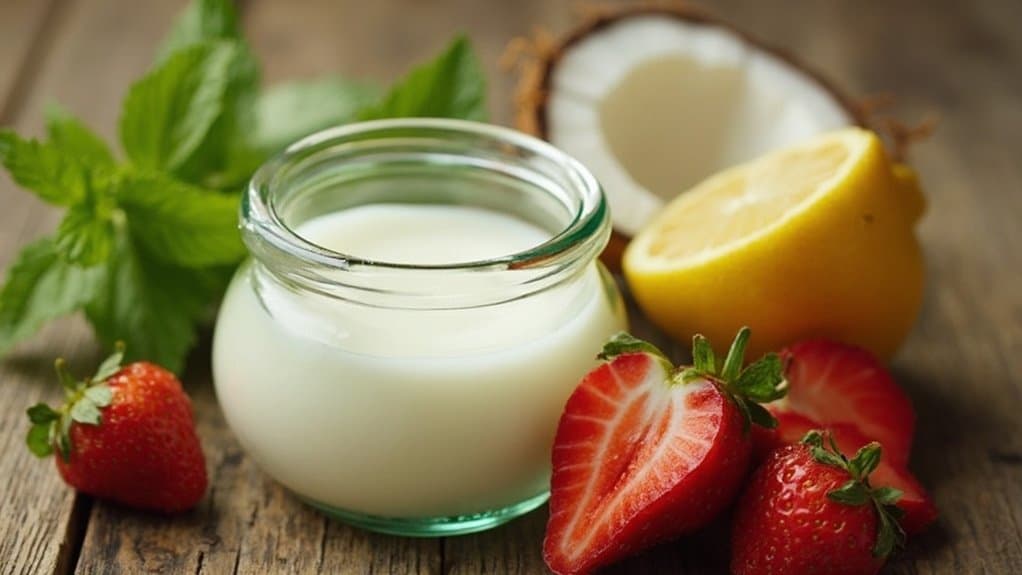10 Natural Teeth Whitening Remedies for a Brighter Smile

If you’re looking to brighten your smile without harsh chemicals, you’ve got plenty of natural options at your fingertips. From simple kitchen staples to fruits packed with benefits, these remedies can enhance your oral health while tackling stains. Each method offers unique advantages, but some may surprise you with their effectiveness. Let’s explore these strategies and see how you can achieve a radiant smile naturally.
Baking Soda: A Simple Abrasive Solution
While you might be looking for effective ways to brighten your smile, baking soda stands out as a simple yet powerful solution. This fine powder, known as sodium bicarbonate, serves as one of the most accessible natural teeth whitening remedies. Its abrasive nature gently lifts surface stains from coffee, tea, and other foods while reducing plaque through its alkaline properties. By neutralizing harmful acids in your mouth, baking soda promotes better oral health and has anticaries properties that help prevent tooth decay. To use it, just mix it with water to form a paste and brush gently. If you stick with it, you might notice results in just a few days.
Hydrogen Peroxide: A Mild Bleaching Agent
Hydrogen peroxide serves as a mild yet effective bleaching agent for teeth whitening, making it a popular choice among many seeking a brighter smile. It acts as an oxidizing agent, breaking down stained molecules to enhance tooth whiteness. With concentrations ranging from 10% to 38%, studies show significant improvements in both surface and intrinsic stains. While higher concentrations yield faster results, using a 3% solution at home is generally safe. It is important to note that ADA recommends no more than 10% hydrogen peroxide for at-home treatments to ensure safety. Always consult a dental professional before starting any whitening regimen, especially if you have existing dental issues. Be mindful of potential side effects, like gum irritation and tooth sensitivity, which can arise from overuse or high concentrations of hydrogen peroxide. Follow product instructions carefully for ideal safety and effectiveness.
Coconut Oil Pulling: An Ancient Oral Care Method
Coconut oil pulling has its roots in ancient Ayurvedic medicine, where people used it to enhance oral health. By swishing coconut oil in your mouth, you can enjoy benefits like reduced plaque and fresher breath. This method is rooted in the practice of oil pulling, which aims to reduce bacteria in the mouth. Let’s explore how to practice this method effectively and the advantages it offers for your oral care routine.
Historical Origins of Pulling
Oil pulling, a practice with roots stretching back 3,000 to 5,000 years, finds its origins in Ayurvedic traditions aimed at balancing doshas and addressing various health issues, particularly oral health.
This ancient method has evolved over time, and you might be surprised by its journey:
- Traditional Purpose: Initially used to treat oral issues and align doshas.
- Common Oils: Sesame and sunflower oils were staples before coconut oil took the spotlight.
- Modern Revival: Gained popularity in the 1990s, now including various oils for natural teeth whitening DIY. Oil pulling is known for its benefits in promoting a healthier mouth.
Today, you can easily incorporate oil pulling into your routine, enjoying its holistic benefits while promoting a brighter smile.
Benefits for Oral Health
Building on the ancient practice of oil pulling, coconut oil has emerged as a powerful ally in maintaining oral health. It effectively reduces harmful bacteria that cause tooth decay and gum disease, thanks to lauric acid’s antimicrobial properties. Additionally, oil pulling is a simple and natural method for oral health enhancement that can easily be integrated into your daily routine.
By minimizing plaque and biofilm formation, you can lower your risk of cavities and gingivitis. This simple method also enhances saliva production, flushing out bacteria and moisturizing your gums for healthier tissues.
Plus, coconut oil acts as a natural teeth whitening remedy, helping to remove surface stains while avoiding harsh chemicals found in commercial products.
Incorporating coconut oil into your routine promotes a balanced oral microbiome and supports overall oral health, leaving you with a brighter smile.
How to Practice Effectively
To effectively practice coconut oil pulling, it’s essential to follow a few straightforward steps that maximize its benefits. This ancient method can help you learn how to naturally whiten teeth while enhancing your oral health.
- Take a tablespoon of organic coconut oil and allow it to liquefy in your mouth.
- Swish the oil for 15 to 20 minutes, ensuring you’re thorough but comfortable.
- Afterward, spit out the oil, rinse your mouth with warm water, and brush and floss as usual. Oil pulling may contribute to improved oral hygiene and fresher breath, making it a beneficial addition to your routine.
Incorporating this routine into your daily oral care can lead to better plaque removal and a brighter smile over time.
Nutritional Approaches: Eating for Teeth Health
While you might think of oral hygiene as mainly about brushing and flossing, what you eat plays an essential role in maintaining healthy teeth.
To learn how to get whiter teeth, focus on nutritional choices that promote dental health. Incorporate calcium-rich foods like cheese, yogurt, and milk to strengthen enamel. Add phosphorus sources such as fish and meat, which help rebuild enamel. Additionally, a balanced diet that includes a variety of nutrient-rich foods supports overall health and dental wellness.
Crunchy fruits and veggies, like apples and carrots, stimulate saliva, naturally cleaning your mouth. Don’t forget vitamin C-rich foods like strawberries and pineapples—they support gum health.
Finally, drink plenty of water, especially fluoridated options, to rinse away bacteria and prevent decay. A balanced diet is key to achieving that brighter, healthier smile!
The Role of Banana Peels in Stain Removal
Banana peels offer more than just a tasty fruit; they contain beneficial nutrients like potassium and magnesium that your teeth can appreciate. While some people swear by their stain-removing properties, it’s important to understand how citric acid in other fruits might affect your enamel. Additionally, bananas provide 23% of daily potassium needs, which is beneficial for muscle function and overall health. Let’s explore how these factors play a role in your quest for a brighter smile.
Nutritional Benefits of Bananas
Teeth whitening can be an essential part of maintaining a bright smile, and bananas offer surprising nutritional benefits that may contribute to oral health.
Incorporating bananas into your diet can provide:
- Vitamins A, B6, and C: These vitamins support healthy teeth and gums.
- Minerals like potassium and magnesium: These may enhance oral health and help in teeth whitening homemade remedies. Additionally, some believe that the tannins and polyphenols in banana peels could aid in removing stains from teeth.
- Natural energy source: Ripe bananas are a great snack, providing around 116 kcal per 100 grams.
While bananas have their advantages, remember to manage their sugar content to avoid potential issues for your teeth.
Citric Acid Properties Explained
Understanding the role of citric acid is essential when exploring natural teeth whitening methods, especially in relation to banana peels.
Citric acid, found in citrus fruits, can erode enamel, making teeth more susceptible to stains, particularly after teeth bleaching. This is why it’s important to avoid citric foods right after whitening. While banana peels contain beneficial minerals, their effectiveness in stain removal is modest and lacks scientific backing. Rubbing the inside of a ripe banana peel on your teeth might help remove some surface stains due to its slightly abrasive texture. However, results can vary based on your dental health and hygiene practices. Always remember to prioritize enamel protection while seeking a brighter smile. Enamel becomes more porous post-whitening, increasing the risk of external staining.
Citrus Peels: Natural Acids for Whitening
Citrus peels, especially those from oranges, offer a natural approach to teeth whitening thanks to their unique compounds. The active d-limonene helps remove surface stains while vitamin C combats bacteria. However, it’s important to use them wisely to avoid enamel erosion. Here are some tips for using citrus peels effectively:
- Use the white part of the peel to minimize irritation.
- Always brush and rinse thoroughly after applying citrus peels.
- Opt for organic oranges to reduce pesticide exposure.
While citrus peels can be a fun, natural option for teeth whitening, remember that results may vary and aren’t as long-lasting as professional treatments. Additionally, the acidic properties of orange peels can damage tooth enamel over time if used excessively. Keep your dental hygiene routine in check to protect your enamel and maintain that bright smile!
Strawberries: Exploring Malic Acid Benefits
While you might enjoy the sweet taste of strawberries, their malic acid content offers potential benefits for whitening your smile. This natural compound helps remove surface stains, giving your teeth a brighter appearance. Malic acid benefits also include boosting saliva production, which is essential for oral health. Unlike harsh chemicals like hydrogen peroxide, malic acid is gentler on your enamel, making it a safer choice for occasional use. However, moderation is key, as excessive consumption can lead to enamel erosion due to acidity. To maximize the malic acid benefits, combine strawberries with your regular dental care routine. Additionally, it’s important to note that high acidity from strawberries can erode tooth enamel over time.
Pineapple: The Enzyme Power of Bromelain
Pineapple isn’t just a tasty treat; it’s packed with bromelain, an enzyme that can help remove stains from your teeth. When you enjoy pineapple, you’re not only getting a delicious snack but also benefiting from its natural whitening properties. Additionally, pineapple increases saliva production to wash teeth clean, helping to enhance its stain-removing effects. However, it’s important to understand its limitations and how to consume it effectively for the best results.
Bromelain’s Stain-Removing Ability
Bromelain, an enzyme extracted from the pineapple plant, offers a natural and effective way to tackle tooth stains. This powerful enzyme works to break down protein-based stains on your teeth, enhancing their brightness without compromising your tooth structure. Additionally, bromelain‘s ability to increase light reflection from tooth surfaces results in a whiter appearance for your smile.
Here are three key benefits of bromelain for achieving a brighter smile:
- It provides similar whitening effects to peroxide without causing sensitivity.
- It preserves healthy teeth by maintaining enamel integrity.
- It’s a safe, natural alternative that supports your overall oral health.
Pineapple Consumption Tips
If you’re looking to harness the teeth-whitening power of bromelain, incorporating pineapple into your diet can be a delightful way to promote oral health. Here are some pineapple consumption tips to keep in mind.
First, enjoy pineapple in moderation due to its high acidity and sugar content, which can harm your enamel. After eating, rinse your mouth with water to reduce acidity. Additionally, the acidic nature of pineapples can contribute to increased dental sensitivity, so it’s important to be mindful of your consumption.
Wait at least 30 minutes before brushing your teeth to allow your enamel to re-solidify. Pair pineapple with crunchy fruits like apples to enhance its benefits while promoting whiter teeth.
Ultimately, staying hydrated helps flush out sugars and acids, further supporting your dental health. With these whiter teeth tips, you’ll enjoy a brighter smile safely!
Limitations of Pineapple Whitening
While pineapple can offer some teeth-whitening benefits thanks to bromelain, it also has its limitations that you should consider.
Here are three key points to keep in mind:
- Allergies and Sensitivity: Bromelain may cause allergic reactions in those allergic to pineapples, and sensitive tissues might react negatively.
- Efficacy: While bromelain can effectively remove surface stains, its whitening power is comparable to low-concentration peroxide and may not match stronger options. However, it is important to note that bromelain does not damage tooth structure like hydrogen peroxide can.
- Research Gaps: Limited studies exist on bromelain’s long-term effects, so you might want to approach its use cautiously.
Turmeric: A Herbal Option for Oral Health
Turmeric, a vibrant yellow spice renowned for its health benefits, offers a unique option for enhancing oral health. This Indian herb is rich in curcumin, which boasts anti-inflammatory and antibacterial properties that may help maintain healthy gums and reduce plaque buildup. Additionally, its antimicrobial properties can cleanse gums and remove impurities that contribute to oral health issues.
Many people use turmeric as a DIY teeth whitening agent, mixing it with coconut oil or baking soda to create a paste. While turmeric might help remove surface stains and freshen breath, keep in mind that its whitening effects are largely anecdotal and lack strong scientific backing. Additionally, turmeric can stain your gums and dental work, so consult with your dentist before incorporating it extensively into your oral care routine.
Activated Charcoal: Temporary Stain Removal
After exploring the benefits of turmeric for oral health, it’s important to reflect on another popular option: activated charcoal.
While it can temporarily improve the appearance of your teeth by removing surface stains, it’s vital to understand its limitations. Here are three key points to take into account:
- Activated charcoal primarily binds to surface impurities, making it less effective on deeper stains.
- Prolonged use can lead to enamel erosion and increased tooth sensitivity, particularly if used excessively.
- Its whitening effects are often comparable to those of regular toothpaste.
Using activated charcoal occasionally may help reduce yellowish plaque, but it shouldn’t replace professional treatments.
Always consult your dentist before adding any new product to your oral care routine to guarantee it’s safe for your dental health.
Frequently Asked Questions
Can Natural Remedies Replace Professional Teeth Whitening Treatments?
Natural remedies can’t fully replace professional teeth whitening treatments. They may offer mild improvements, but if you want significant, immediate results, you’ll need to contemplate professional options for a brighter, healthier smile.
How Long Does It Take to See Results From Natural Whitening Methods?
You won’t see immediate results from natural whitening methods. Consistent use over weeks may offer gradual improvements, but individual factors like stain type and overall oral health greatly impact how quickly you notice changes.
Are There Any Side Effects From Using Natural Teeth Whitening Remedies?
Yes, you can experience side effects from using natural teeth whitening remedies. These may include tooth sensitivity, gum irritation, enamel erosion, and even dry mouth. Always be cautious and consult with a professional for safe options.
Can I Use Multiple Natural Whitening Remedies at Once?
You can use multiple natural whitening remedies at once, but be cautious. Mixing them may increase the risk of enamel erosion and sensitivity. It’s best to consult your dentist before starting any combined treatment.
How Often Should I Use Natural Whitening Methods for Best Results?
You should use natural whitening methods sparingly for best results. Incorporate them once or twice a week, depending on the remedy, and always listen to your teeth to avoid sensitivity or damage.
Conclusion
Incorporating these natural teeth whitening remedies into your routine can help you achieve a brighter smile while maintaining good oral health. Whether you opt for baking soda, coconut oil pulling, or the power of fruits like strawberries and pineapple, you’re on the right track. Just remember to use these methods wisely and in moderation. With consistent care and a few simple changes, you’ll be well on your way to a more radiant, confident smile!
References
- https://www.pleasantfamilydentistry.com/blog/6-natural-ways-to-whiten-your-teeth
- https://glenburniedentalgroup.com/blog/5-natural-teeth-whitening-remedies/
- https://www.healthline.com/nutrition/whiten-teeth-naturally
- https://www.dentistryformidtown.com/blog/natural-teeth-whitening-remedies-separating-fact-from-fiction/
- https://www.bhandaldentistry.co.uk/news/does-natural-teeth-whitening-work
- https://gloscience.com/blogs/blog/teeth-whitening-with-baking-soda
- https://www.smilesofcary.com/natural-teeth-whitening
- https://maindentistry.com/dental-health/baking-soda-boost-how-long-does-it-take-to-whiten-teeth/
- https://tenczadental.com/does-baking-soda-whiten-teeth/
- https://zaradental.com/hydrogen-peroxide-teeth-whitening/






